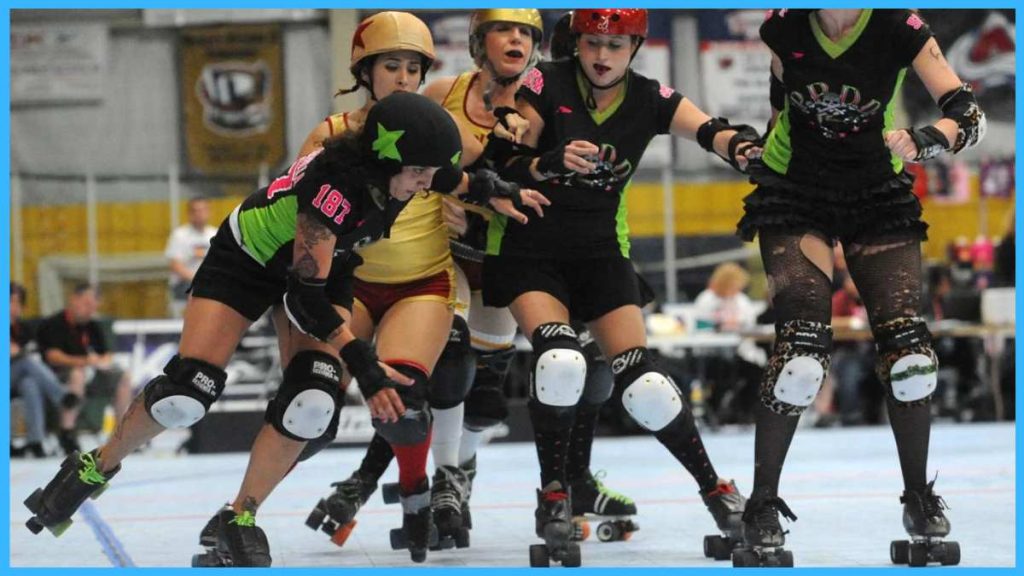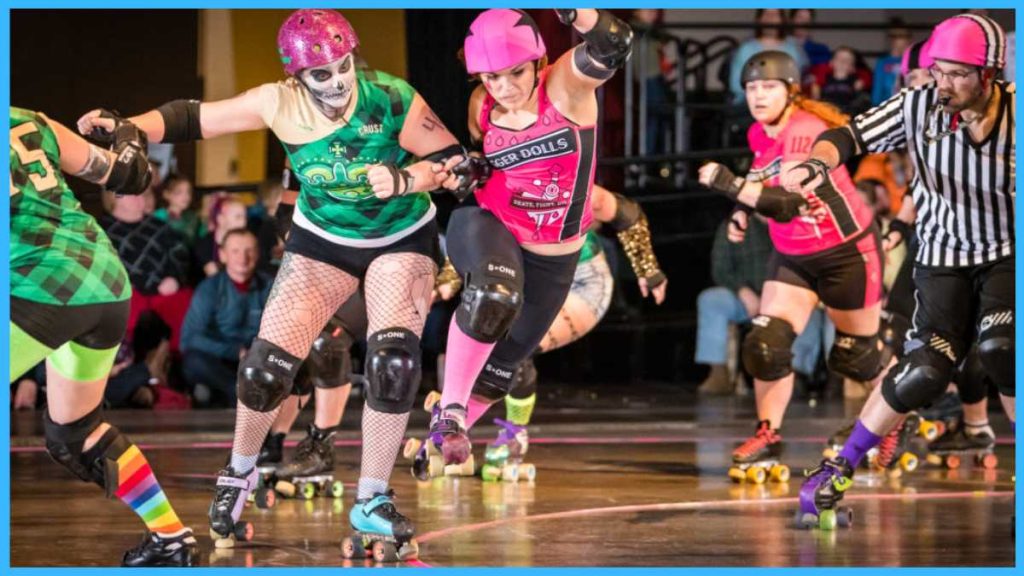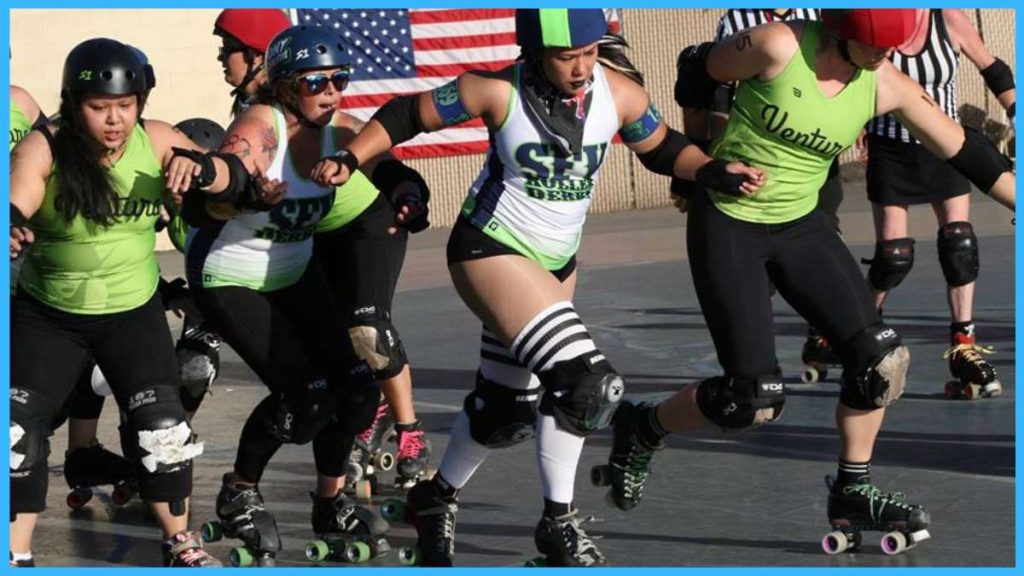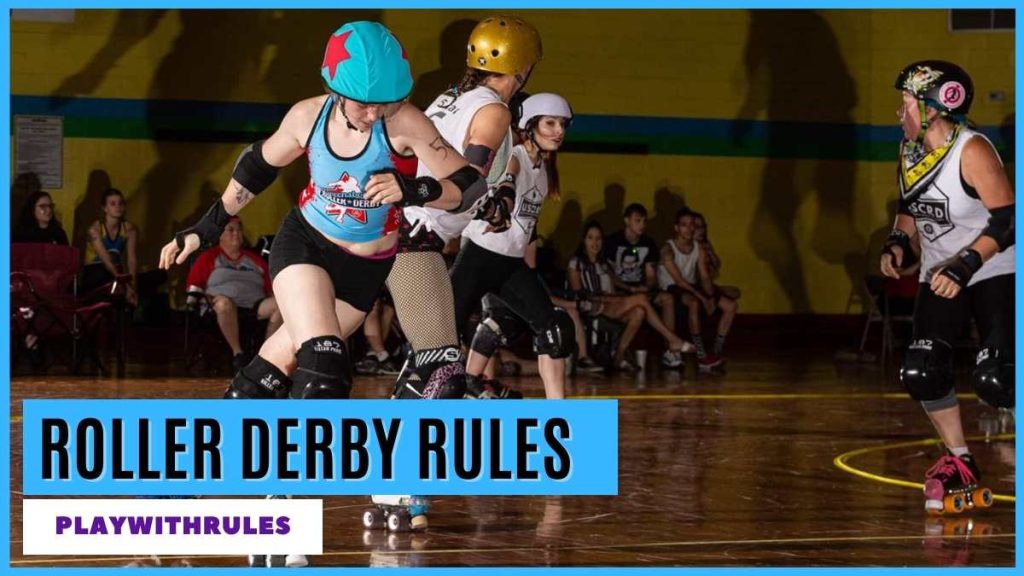If you ask what makes Roller Derby so popular among contact-sport fans? Well, it definitely has a lot to do with the electrifying and high-energy spirit of the game. That could be played following the rules of roller derby. Roller Derby, as undemanding as it sounds, is an exhilarating sport that combines speed, physicality, strategy, and passion.
Roller Derby is a team sport, but your impact on the game also decides the fate of your team. It is a full-body-contact sport where you must skate, dodge, push, and persevere to victory. Sounds like a game you would be interested in? Then, let’s learn more about Roller Derby!
How To Play Roller Derby?
If you wonder how to play roller derby, then fret no more. In this game, two teams compete with each other on an ice-staking rink that can either be flat or banked along the edges (to increase the thrill of the game). Since it is a full-contact sport, each team nominates a player to break through the opposition’s defense and race and beat the opposing team’s player who does the same.
Each team has a defensive and an offensive role. The nominated player who runs the laps around the players is called a Jammer, and the players who block the jammer are called Blockers. Let’s proceed step-by-step to understand the Roller Derby rules better.
Objective
The objective of each team is to score higher than their opponent by doing as many laps around the opponent players as possible. Sounds simple, right? Well, it isn’t. A timer is on, and the jammers need to do as many laps as they can while their teammates act as blockers against the opposing jammer who is also trying to score higher than you.

Roller Derby Rules
There is no ball or object around which the game is played. Sounds confusing? To better understand the game, imagine running a racetrack with quad roller skates on while your opponents block you with their shoulders and hips. It is a physical game, but there is more to it than that. Let’s learn about the Roller Derby rules in a little more detail:
1. General Rules Of Roller Derby
In this section of the article, we shall elucidate the general rules of the game and its gameplay. The rules of Roller Derby are as follows:
-
- Roller derby teams may consist of 14 players each. However, up to 5 players can be on the skating rink (active players) at one time.
-
- Each team consists of 1 jammer (the only player who can score) and 4 blockers (players who work unison to prevent the opposing team’s jammer from scoring).
-
- Roller Derby is played on an oval track. This track can either be flat or angled (banked) along the sides.
-
- At the beginning of a match, the four blockers from each team skate a lap around the rink within the designated tracks. Then, the whistle is blown once the pack crosses the starting line. However, the last member (Jammer) should stay at least 30 feet across the starting line. After that, the jammers from each team start skating.
-
- The jammers try to use force and technique to push through, evade, or bypass the other team’s blockers. Roller Derby matches have two rounds of 30 minutes each.
2. Jammers
Jammers are the players who score for their team. Their job is to go through the opposing team’s blocker pack and score as many points as possible. Let us explain the role of a jammer and the rules associated with that position:
-
- As per the Roller Derby Rules, Jammers are the players whose helmets are marked with a star.
-
- Jammers need to use force and technique to force their way through or evade the opposing blockers.
-
- Once a jammer is through the pack, they are in a position to score.
-
- To score, the jammer needs to do a lap around the rink and evade and pass through each opposing team player.
-
- The jammer’s team is awarded one point for every blocker that they lap past.
-
- Since a timer is on, each jammer must skate fast past the blockers to score. This is called a ‘Jam’. Every jam lasts for two minutes. A jammer aims to skate fast and past as many blockers as possible to get the highest score possible.
-
- The first jammer to pass the opposition’s blockers becomes the lead jammer.
-
- Being a lead jammer has many advantages. For example, the lead jammer can stop the timer before the two-minute round is up by tapping their hips with both hands. This prevents the opposing team’s jammer from overtaking or beating their score.
3. Blockers
Blockers are the 4 players other than the jammer, who try to help the jammer while simultaneously trying to block the opposition’s jammer from going past them. Here are the rules and regulations that blockers need to follow:
-
- According to the rules of Roller Derby, the blockers are players who play both offense and defense for their team.
-
- Blockers can use only their shoulders and hips to slow their opponent’s jammer.
-
- Blockers can form a chain by holding hands to prevent the jammer from going through them. However, they can only tackle from the front and side and not use any other part of their body (other than the shoulders and hips) to push their opponent off the track or block their progress.
-
- Blockers cannot charge, block, or push from behind a player. If the opposing team’s jammer gets past them, they must catch up to them again and try blocking them from the side or the front.
4. Game Duration
A typical roller derby game lasts 60 minutes (1 hour). It consists of two halves, each lasting 30 minutes.

Important Terms & Rules Of Roller Derby
The above information will suffice if the idea introduces the reader to a new sport. But wouldn’t you like to know more about this exciting game? What are the important terms associated with it? Read on to find out:
Pivot
Pivots are part of each team’s blocking squad. However, they have special abilities. Pivots can be identified as the players who wear helmets with a stripe down the middle. They are responsible for dictating the strategy, controlling the pace of the game, and blocking the opponent’s jammer as well. But that is not all. A pivot is the only player with the power to become the jammer in the middle of a jam (play). To do that, a pivot must take the star from the jammer.
Out Of Bounds
The skating rink/court plays a pivotal role in the game and has regulations. For example, a player who goes out of bounds is not allowed.
-
- A player cannot go outside the track (the designated area) purposely or by accident.
-
- If a player goes outside the tracks, they have to re-enter them, but first, they must go behind the opponent team’s pivot.
Contact
Roller derby is a physical game – no doubt about it. The thing about games like roller derby is that if rules are not followed, players are more likely to get hurt. That is why there are stringent regulations in place about contact.
Blockers can only make frontal or body-side contact, which must be above the knee level. They cannot kick, punch, elbow, trip, clothesline, hit, or slam their opponents during the game. Doing so will result in a penalty (explained further later).
Power Jam
A power jam is like an advantage given to a team. When a power jam is in progress, the opposing team’s jammer has to sit inside the penalty box for 30 seconds. This means that the other jammer has the opportunity to score as many points as they can since the opposing team’s jammer cannot play for that duration.
A Power Jam is basically a 30-second penalty against one of the jammers. If played properly, a Power Jam can prove very useful to a team at any point during the game.
Scoring
Truth be told, it is not very easy to score in roller derby. There is no goal, and there is no area to get to. Only the jammer can score in roller derby by skating past opponent players. Every player that a jammer skates past (pushes past, dodges, etc.), their team earns a point.
However, the blockers also play a significant role in the scoring process. The blockers prevent the opposing team’s jammer from scoring and aid their jammer in scoring.
Penalty
While scoring can lead you to victory, a penalty is an integral part of any game with a chance of foul play. The idea behind a penalty is to penalize encounters that are disallowed. In roller derby, penalties are common due to the game’s nature. Here’s everything you need to know about penalties in roller derby:
-
- If penalized, the referee can award a 30-second penalty against that player.
-
- The penalized player must sit in the penalty box for 30 seconds while the jam progresses.
-
- If a player is penalized seven times (7 penalties overall), they are immediately disqualified from the game.
-
- While a player can be penalized in multiple ways, one of the most common reasons behind penalties in roller derby is unacceptable forms of contact (e.g., elbows, tripping).
-
- If a player incurs another penalty during their serving time, their time is extended.
Penalty box
Players can be sent to the penalty box for several reasons. This can include illegal contact, cutting tracks, and blocking from behind. Here are the Roller Derby rules of the penalty box:
-
- The penalty box is a designated area where the penalized players must sit for 30 seconds.
-
- After sitting inside the penalty box for 30 seconds, a player may re-enter the track but behind the pack. This is done to prevent further fouls.
- If the penalty box is full, additional players are made to wait in a separate waiting area. The penalty box can hold a maximum of 3 players per team.
Penalty box Manager
In roller derby, the Penalty Box Manager plays a vital role in maintaining the flow of the game by overseeing the penalty box area. They are responsible for tracking and enforcing player penalties, ensuring skaters serve the correct amount of time for infractions. The Penalty Box Manager monitors skaters entering and exiting the box, communicates with officials to confirm penalties, and ensures the box is never overfilled, maintaining fairness and order on the track. Their attention to detail helps keep the game running smoothly while upholding the rules.

Winning
At the end of 60 minutes (1 hour), the team with the higher score wins the game.
Tips & Strategies
Roller derby is an ultra-competitive game where scoring is quite tricky. There is little room for the jammers to score, and far too many blockers are in each match. Additionally, it is difficult for the blockers to maintain balance and block jammers. So, how do you get better at this game? Here are a few crucial tips that will enhance your roller derby game skills incredibly:
-
- Explosive Leg Power – The key here is to get ahead of the other blockers and the opposing team’s jammer as quickly as possible. Your acceleration plays a significant role in giving you an advantage over the others in this regard. Practice short, explosive bursts to get enough acceleration to brush past the blockers and become the lead jammer.
-
- Edge Work—If you want to improve at roller derby, put in a lot of edge work. Roller derby is not just about blind physical contact. Staying within the designated track area is difficult when the game gets going. Therefore, it is very important to have track awareness, and that comes with abundant practice.
-
- Versatility – The one quality that has worked wonders for roller derby players is their ability to play well as both a blocker and a jammer. Even if you specialize in one aspect of the game, make sure you work on the other aspect and develop it. Not only will this help you analyze overall game strategy to make better calls, but you will also be able to exercise more control on the field of play.
-
- Communication—Work on communication with your team. So be it if that means developing keyphrases and keywords that only your team can understand. Coordination and communication are key in this game, mainly because the teams are so close to one another throughout the game. Work on communication so that you can strategize mid-jam without the other team realizing it.
FAQs
What are the main positions in roller derby?
Is roller derby a dangerous sport?
Can anyone play roller derby?
How are penalties handled in roller derby?
Did You Know?
-
- Roller Derby originated in the United States in the 1930s. Initially, it was marathon skating, which later evolved into a contact sport.
-
- Roller Derby is a sport dominated by women, although there is also a men’s division.
-
- The Women’s Flat Track Derby Association is the largest governing body of Roller Derby, overseeing about 400 leagues.
-
- Roller Derby is famous for having one of the most supportive and inclusive sports communities.
Conclusion
All in all, roller derby is a game that was born out of entertainment. Naturally, one cannot deny that watching a roller derby game is quite exciting. There are specific rules of roller derby, but none are as complicated. With a supportive community and the electrifying spirit of the game, it is hard to say no to the game. So make sure you understand the Roller Derby rules well before stepping out onto the skating rink and having fun!
Think you know enough? Get, set, and Roll! Keep coming back to Play With Rules for more such impactful learning on sports around the world.

